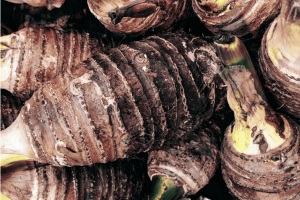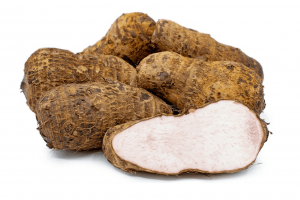How to Grow Taro Root from Seed to Harvest
Taro root (Colocasia esculenta L.) is an important crop in Telangana. Taro root leaves are also used as a curry. Taro roots are boiled or fried or roasted over fire and used to make curry. Taro root is rich in carbohydrates, calcium, iron, phosphorus, vitamin ‘A’ and ‘C’.
It is cultivated in Rangareddy, Medak, Warangal, Nizamabad and Mahbubnagar districts of Telangana state.

In this article I have explained How to grow taro root from Seed to Harvest, which helps every farmer and home gardener to gain the knowledge on
- Available verities of Taro root.
- Seed germination time.
- Suitable soil and weather conditions.
- Field preparation and planting distance.
- Fertilizer and Water Management.
- Required seed per acre and expected yield per acre.
Weather:
This is a tropical crop, which requires high soil moisture at all times.
Soils:
Well-drained sandy soils, sandy alluvial soils are best suited. It is also grown in red clay soils, black clay soils and soils with Soil PH levels 5.5–7.0 suitable. More organic fertilizers should be used to retain these in the soil and increase its availability. In shallow soils, more organic manure can be added and cultivated.
Seed Dose:
Young taro roots are used as seed. 14,000 taro roots (400-600 kg) are used per acre. Germinated baby taro roots can be stored for up to two months.
Seed Per Acre:
Seed Rate: 14,000 taro roots (400-600 kg) are used per acre.
Harvesting: 210-225 Days
Yield: 8-14 tones per acre
Varieties:
Shatamukhi, Panchmukhi, N.D.C. – 2 and Birban local, Srirashmi, Sri Pallavi are high yielding varieties.
Shatamukhi : It is a variety released from Acharya NG Ranga Agricultural University. The plants grow bushy and the baby branches come out well from the mother taro root. The plant is 50-55 cm tall and has 6-7 leaves. The leaves are dark green in color and the stem is pink in color. Taro roots are low in gluten with low oxalates. Resistant to leaf blight. Harvesting period: 210-225 days. Yield : 8 t/a.
Bhavpuri: Harvesting Period: 8 months, yield 14.0 tones/a.
K.C. S – 3: Harvest period : 5 months, yield : 9.6 tons/a.
Planting:
The soil should be made into small holes. Proper drainage should be done to give water. The baby taro roots should be planted parallel to the ground at a distance of 45×30 cm at a depth of 10 cm. After planting taro roots should be covered with soil and dry paddy straw should be covered on top. This will prevent the weed from growing quickly.
Water Management:
After planting taro root for the first time, water should be given. The first two months should be watered more. Give moisture for 3-4 days. Watering is very important during the growth stage of the plant and during the taro root formation stages. Watering the taro root once before cultivating makes them easy to cultivate.
Intercrops:
Taro root can be intercropped in coconut and banana plantations. French beans and radish crops which are short term crops can be inter-cropped (first two months) in taro root field.
Harvesting:
At the ripe stage of the harvest, the leaves turn yellow and dry. The taro root can be cultivated and picked by laborers using pickaxes or it can be plowed with a plough. The baby taro root should be separated from the mother taro root, the roots and soil should be removed and cleaned and covered with rice straw.
Light watering should be given if taro root cultivation is delayed for 15 days or more. Due to this, taro root do not lose weight.

Post-harvest precautions:
After cleaning the cultivated taro root should be kept in shade. These tubers should be covered with rice straw and sprinkled with water, thus the taro root do not lose weight.
Follow WalPencil to get to know cultivation tips for other vegetable crops like Malabar Spinach, Coriander, Potato etc.
